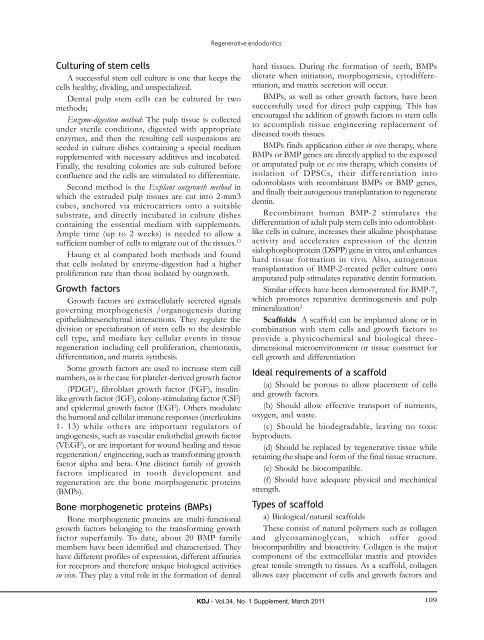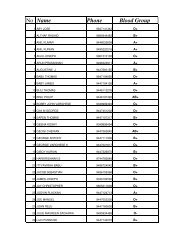Vol 34 No 2 suppli final.pmd - IDA KERALA STATE ::. idakerala.com
Vol 34 No 2 suppli final.pmd - IDA KERALA STATE ::. idakerala.com
Vol 34 No 2 suppli final.pmd - IDA KERALA STATE ::. idakerala.com
Create successful ePaper yourself
Turn your PDF publications into a flip-book with our unique Google optimized e-Paper software.
Culturing of stem cells<br />
A successful stem cell culture is one that keeps the<br />
cells healthy, dividing, and unspecialized.<br />
Dental pulp stem cells can be cultured by two<br />
methods;<br />
Enzyme-digestion method: The pulp tissue is collected<br />
under sterile conditions, digested with appropriate<br />
enzymes, and then the resulting cell suspensions are<br />
seeded in culture dishes containing a special medium<br />
supplemented with necessary additives and incubated.<br />
Finally, the resulting colonies are sub cultured before<br />
confluence and the cells are stimulated to differentiate.<br />
Second method is the Explant outgrowth method in<br />
which the extruded pulp tissues are cut into 2-mm3<br />
cubes, anchored via microcarriers onto a suitable<br />
substrate, and directly incubated in culture dishes<br />
containing the essential medium with supplements.<br />
Ample time (up to 2 weeks) is needed to allow a<br />
sufficient number of cells to migrate out of the tissues. 13<br />
Haung et al <strong>com</strong>pared both methods and found<br />
that cells isolated by enzyme-digestion had a higher<br />
proliferation rate than those isolated by outgrowth.<br />
Growth factors<br />
Growth factors are extracellularly secreted signals<br />
governing morphogenesis /organogenesis during<br />
epithelialmesenchymal interactions. They regulate the<br />
division or specialization of stem cells to the desirable<br />
cell type, and mediate key cellular events in tissue<br />
regeneration including cell proliferation, chemotaxis,<br />
differentiation, and matrix synthesis.<br />
Some growth factors are used to increase stem cell<br />
numbers, as is the case for platelet-derived growth factor<br />
(PDGF), fibroblast growth factor (FGF), insulinlike<br />
growth factor (IGF), colony-stimulating factor (CSF)<br />
and epidermal growth factor (EGF). Others modulate<br />
the humoral and cellular immune responses (interleukins<br />
1- 13) while others are important regulators of<br />
angiogenesis, such as vascular endothelial growth factor<br />
(VEGF), or are important for wound healing and tissue<br />
regeneration/ engineering, such as transforming growth<br />
factor alpha and beta. One distinct family of growth<br />
factors implicated in tooth development and<br />
regeneration are the bone morphogenetic proteins<br />
(BMPs).<br />
Bone morphogenetic proteins (BMPs)<br />
Bone morphogenetic proteins are multi-functional<br />
growth factors belonging to the transforming growth<br />
factor superfamily. To date, about 20 BMP family<br />
members have been identified and characterized. They<br />
have different profiles of expression, different affinities<br />
for receptors and therefore unique biological activities<br />
in vivo. They play a vital role in the formation of dental<br />
Regenerative endodontics<br />
hard tissues. During the formation of teeth, BMPs<br />
dictate when initiation, morphogenesis, cytodifferentiation,<br />
and matrix secretion will occur.<br />
BMPs, as well as other growth factors, have been<br />
successfully used for direct pulp capping. This has<br />
encouraged the addition of growth factors to stem cells<br />
to ac<strong>com</strong>plish tissue engineering replacement of<br />
diseased tooth tissues.<br />
BMPs finds application either in vivo therapy, where<br />
BMPs or BMP genes are directly applied to the exposed<br />
or amputated pulp or ex vivo therapy, which consists of<br />
isolation of DPSCs, their differentiation into<br />
odontoblasts with re<strong>com</strong>binant BMPs or BMP genes,<br />
and <strong>final</strong>ly their autogenous transplantation to regenerate<br />
dentin.<br />
Re<strong>com</strong>binant human BMP-2 stimulates the<br />
differentiation of adult pulp stem cells into odontoblastlike<br />
cells in culture, increases their alkaline phosphatase<br />
activity and accelerates expression of the dentin<br />
sialophosphoprotein (DSPP) gene in vitro, and enhances<br />
hard tissue formation in vivo. Also, autogenous<br />
transplantation of BMP-2-treated pellet culture onto<br />
amputated pulp stimulates reparative dentin formation.<br />
Similar effects have been demonstrated for BMP-7,<br />
which promotes reparative dentinogenesis and pulp<br />
mineralization 2<br />
Scaffolds A scaffold can be implanted alone or in<br />
<strong>com</strong>bination with stem cells and growth factors to<br />
provide a physicochemical and biological threedimensional<br />
microenvironment or tissue construct for<br />
cell growth and differentiation<br />
Ideal requirements of a scaffold<br />
(a) Should be porous to allow placement of cells<br />
and growth factors.<br />
(b) Should allow effective transport of nutrients,<br />
oxygen, and waste.<br />
(c) Should be biodegradable, leaving no toxic<br />
byproducts.<br />
(d) Should be replaced by regenerative tissue while<br />
retaining the shape and form of the <strong>final</strong> tissue structure.<br />
(e) Should be bio<strong>com</strong>patible.<br />
(f) Should have adequate physical and mechanical<br />
strength.<br />
Types of scaffold<br />
a) Biological/natural scaffolds<br />
These consist of natural polymers such as collagen<br />
and glycosaminoglycan, which offer good<br />
bio<strong>com</strong>patibility and bioactivity. Collagen is the major<br />
<strong>com</strong>ponent of the extracellular matrix and provides<br />
great tensile strength to tissues. As a scaffold, collagen<br />
allows easy placement of cells and growth factors and<br />
KDJ - <strong>Vol</strong>.<strong>34</strong>, <strong>No</strong>. 1 Supplement, March 2011<br />
109




